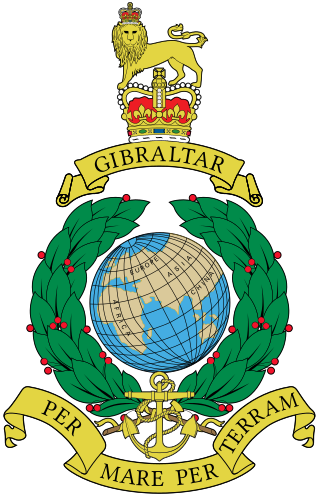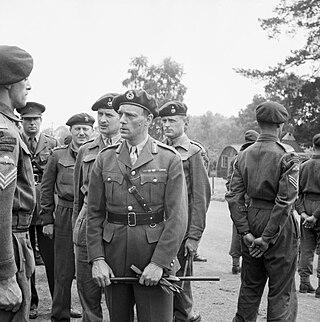
The Corps of Royal Marines (RM), also known as the Royal Marines Commandos, are the United Kingdom's special operations capable commando force, amphibious light infantry, and also one of the five fighting arms of the Royal Navy. The Royal Marines trace their origins back to the formation of the "Duke of York and Albany's maritime regiment of Foot" on 28 October 1664, and can trace their commando origins to the 3rd Special Service Brigade, now known as 3 Commando Brigade, which was formed on 14 February 1942, during the Second World War. The Corps also provides the Naval Musicians.

Military police (MP) are law enforcement agencies connected with, or part of, the military of a state. In wartime operations, the military police may support the main fighting force with force protection, convoy security, screening, rear military reconnaissance, logistic traffic management, counterinsurgency, and detainee handling.
45 Commando Royal Marines is a battalion sized unit of the British Royal Marines and subordinate unit within 3 Commando Brigade Royal Marines, the principal Commando formation, under the Operational Command of the Fleet Commander.

The Royal Military Police (RMP) is the corps of the British Army responsible for the policing of army service personnel, and for providing a military police presence both in the UK and while service personnel are deployed overseas on operations and exercises. Members of the RMP are often known as 'Redcaps' because of the scarlet covers on their peaked caps and scarlet coloured berets.

The green beret was the official headdress of the British Commandos of the Second World War. It is still worn by members of the Royal Marines after passing the Commando Course, and personnel from other units of the Royal Navy, Army and RAF who serve within 3 Commando Brigade and who have passed the All Arms Commando Course.

Royal Marines Barracks Chivenor is a British military base used primarily by 3 Commando Brigade. It is situated on the northern shore of the River Taw estuary, adjacent to the South West Coast Path, on the north coast of Devon, England. The nearest towns are Barnstaple and Braunton.

The 43 Commando Fleet Protection Group Royal Marines, formerly Comacchio Company Royal Marines (1980–1983), Comacchio Group Royal Marines (1983–2001) and Fleet Protection Group Royal Marines (2001–2012), is a 550-man unit of the Royal Marines responsible for guarding the United Kingdom's nuclear weapons. The unit, based at HM Naval Base Clyde, is part of 3 Commando Brigade.

The Royal Navy Police (RNP) is the service police branch of the Royal Navy and Royal Marines. Members of the RNP enforce service law and discipline.

The Royal Air Force Police (RAFP) is the service police branch of the Royal Air Force, headed by the provost marshal of the Royal Air Force. Its headquarters are at RAF Honington and it deploys throughout the world to support RAF and UK defence missions.

His Majesty's Naval Service is the United Kingdom's naval warfare and maritime service. It consists of the Royal Navy, Royal Marines, Royal Fleet Auxiliary, Royal Naval Reserve, Royal Marines Reserve and Naval Careers Service. The term Naval Service should be distinguished from the "UK Naval Services", which consist of the Naval Service and the Merchant Navy. The Naval Service as a whole falls under the command of the Navy Board, which is headed by the First Sea Lord. This position is currently held by Admiral Sir Ben Key. The Defence Council delegates administration of the Naval Service to the Admiralty Board, chaired by the Secretary of State for Defence.

The Royal Marines Band Service is the musical wing of the Royal Navy and an independent element of the Royal Marines. It currently consists of five bands plus a training wing – the Royal Marines School of Music at HMS Nelson – and its headquarters is at HMS Excellent, Whale Island, Portsmouth.
47 Commando Royal Marines, formerly 1 Assault Group Royal Marines, is a unit of Royal Marine Commandos that specialise in amphibious assault and raiding, as well as small boat operations, both amphibious and riverine. The unit falls under 3 Commando Brigade. In addition, it trains personnel for the Assault Squadrons of the Royal Marines (ASRM) and their landing craft detachments. It is based at RM Tamar in HMNB Devonport, Plymouth.

Gerak Khas, or Grup Gerak Khas, also spelled Gerakhas, is a Malaysian Army special forces unit that performs special operations missions such as direct action, unconventional warfare, sabotage, counter-terrorism, and intelligence gathering. Gerak Khas was founded in 1965 during the Indonesia-Malaysia conflict, and they gained worldwide fame and recognition after successfully pacifying the communist insurgency in Malaysia's jungles between 1968 and 1989.
40 Commando RM is a battalion-sized formation of the British Royal Marines and subordinate unit within 3 Commando Brigade, the principal Commando formation, under the Operational Command of Commander in Chief Fleet. Their barracks are at Norton Manor Camp, Norton Fitzwarren near Taunton in Somerset.

Provosts are military police (MP) whose duties are policing solely within the armed forces of a country, as opposed to gendarmerie duties in the civilian population. However, many countries use their gendarmerie for provost duties.
The red beret is a military beret worn by many military, paramilitary, commando, and police forces and should not be confused with the maroon beret worn by airborne troops all around the world.
30 Commando Information Exploitation Group RM, or 30 Commando (IX) Group, is a battalion-sized unit of the Royal Marines and forms part of 3 Commando Brigade. The unit resources include communications, information operations, information systems, intelligence, surveillance, and Target Acquisition and Reconnaissance (ISTAR).

In the United Kingdom, the term military police refers to the three branches of the service police. Often, the term 'military police' is considered synonymous with the Army's Royal Military Police, but in fact, has a wider context. There are a number of civilian police forces whose role is to police other parts of the Defence Estate in the UK and overseas, but such forces are not correctly referred to as military police.

Troops began wearing berets as a part of the headgear of military uniforms in some European countries during the 19th century; since the mid-20th century, they have become a component of the uniforms of many armed forces throughout the world. Military berets are usually pushed to the right to free the shoulder that bears the rifle on most soldiers, but the armies of some countries, mostly within Europe, South America, and Asia, have influenced the push to the left.
In 1989 the Royal Navy was under the direction of the Navy Department in the UK Ministry of Defence. It had two main commands, CINCFLEET and Naval Home Command.














